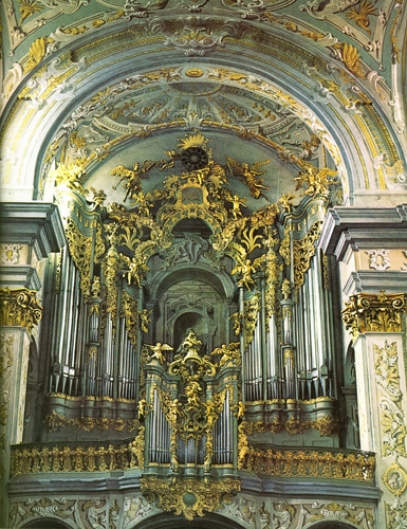


Herzogenburg

Johann Hencke 1749-1752
Hencke's organ in Herzogenburg had quite a few uncommon peculiarities. The case design resembles the contempory preference for divided cases around a window - but there is no window. Instead the case design is continued in trompe l'oeuil in an ingenious way of integrating the organ within one of the most spectacular examples of baroque organ architecture.
Hencke designed a three manual organ uncommonly big for the region. The Kleinpositiv resembles a solo cornet in French style, but Hencke's plan shows some individual patterns with a multitude of character colours combined with a rich Plenum and typical double mixture stops. While a reed-less main organ is uncommon even this far south this is partly compensated by the strong pedal with its two trombone stops. The parapet positive (+ Cornet decomposèe) are designed as solo divisions offering a kind of chamber music contrast like concertino soloists in relation to a ripieno orchestra in a baroque concerto grosso.
Specification (contract 1749)
III+P
HW:
Prestant 16’
Principal Fleten 8’
Octav 8’
Quintadena 8’
Waldtfleten 8’
Octav 4’
Nachthorn 4’
Spitzfleten 4’
Quint 3’
Superoctav 2’
Mixtur major 8f.
Mixtur minor 5f.
Rauschquint 3f.
Pos:
Principal 8’
Coppel 8’
Salici[o]nal 8’
Gamba 8’
Octav 4’
Dulciana 4’
Fleten gedeckt 4’
Quinta 3’
Octav 2’
Mixtur 5f.
Cimbl ½’ 2f.
Krum Horn 8’
Kleines Pos:
Copel 8’
Fleten 4’
Principal 2’
Quinta 1½’
Sedecima 1’
P:
Principal 16’
Contrabaß 16’
Quintadena 16’
Octav 8’ (tin)
Octav 8’ (wood)
Quinta 6’
Mixtur 4’ 10f.
Groß Posaunen 16’
Octav Posaun 8’
Couplers Kpos/Pos, Pos/HW
© Greifenberger Institut für Musikinstrumentenkunde | info@greifenberger-institut.de



